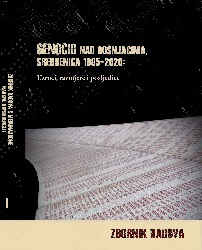Genocid u Srebrenici: završni pečat 20. stoljeću
The Srebrenica Genocide: The Final Seal to the 20th Century
Author(s): Dželal Ibraković
Subject(s): Local History / Microhistory, Political history, Government/Political systems, Studies in violence and power, Victimology, Transformation Period (1990 - 2010), Politics and Identity
Published by: Institut za istraživanje zločina protiv čovječnosti i međunarodnog prava Univerziteta u Sarajevu
Keywords: Genocide; ideology; Bosniaks; Srebrenica; paradigm; denial and negation;
Summary/Abstract: The crime in Srebrenica completes and completes the barbaric campaign of the two expansionist regimes that created Greater Serbia and Greater Croatia with fire and sword. Srebrenica is a hub of the map and network of crimes against Bosniaks and is only one of the drastic variations of the attitude towards Bosniaks as “others” and over which the medieval anathema and their living space is divided on the Serbia-Croatia route. The basis of the legal legalization of these agreements is the Cvetković Maček agreement, created at the time of open sympathies for fascism and already formed Ustasha and Chetnik organizations. It was through these two fascist offshoots that the Second World War brought the largest percentage of casualties in Yugoslavia, in relation to the number of inhabitants, among Muslims, and these crimes were not prosecuted. For a long time, communist ideology treated Bosniaks as a religious group, not a nation, and the “recognition” of the nation took place under the religious name of Muslim, leaving only Bosnia and Herzegovina without a people whose ethnonym has ties to their homeland. This left the possibility to “legalize” the crime because in 1993 the Assembly of the Serbian people in Bosnia and Herzegovina passed a conclusion: “that Muslims are a communist creation and represent a religious group of Turkish orientation... We do not accept this artificial nation.” We believe that Muslims are a sect, a group, of Turkish orientation... “The pattern of “liberators”, “winners”, “anti-fascists” was established and included in the manuals that were applied in practice in Bosnia and Herzegovina in years 1992–1995. and they refer to the class, religious, ideological and any other opponent, which “someone” officially marked as such. According to the “revolutionary” principle towards such an enemy, which officially does not exist, all means from the arsenal of Lenin’s “revolutionary terror” or Stalin’s gulags, Hitler’s gas chambers and concentration camps, Manjaca, Prijedor, Heliodrom, Srebrenica, whatever they call it, are allowed.
- Page Range: 127-157
- Page Count: 31
- Publication Year: 2021
- Language: Bosnian
- Content File-PDF

